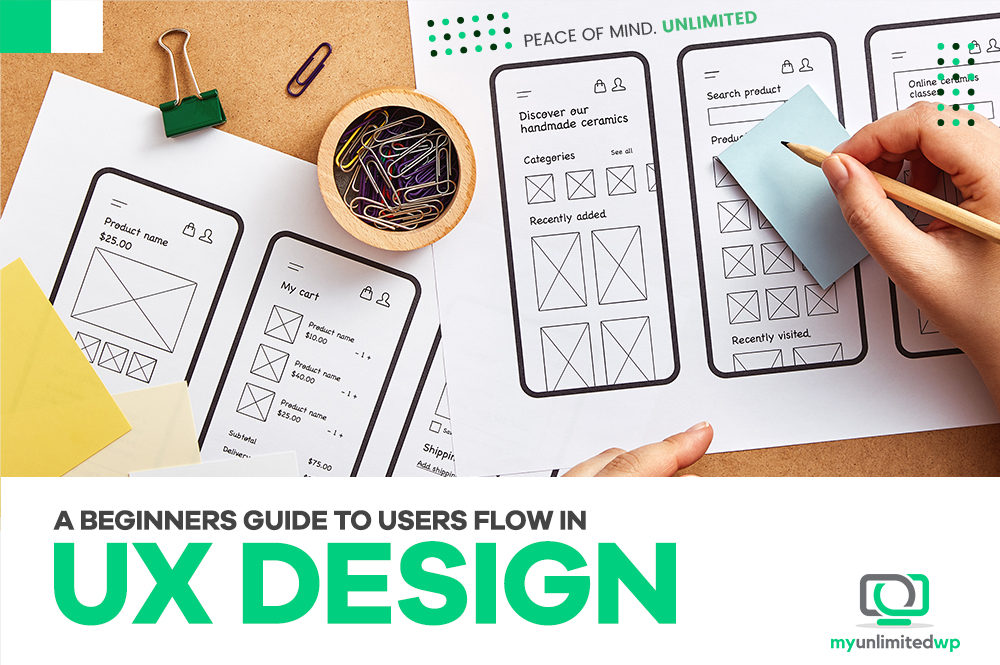Overview: Users flow is all about guiding your visitor through a seamless journey on your website or app. As a business owner, this is what we’re all about — wouldn’t you agree? This guide will help you navigate your users flow journey by stepping into their shoe and doing the best for them. Read on to learn more!
Do you ever find yourself lost on a website, trying to finish what should be a simple task? Maybe you’re trying to purchase a product but ended up abandoning the process because it’s all too overwhelming? This experience is often the result of a poorly designed users flow.
On the hand, you open a website and buy a product or service seamlessly. The credit simply goes to a carefully constructed users flow which results in an intuitive, smooth, and enjoyable customer experience. When it’s all done, you might not even notice it, but a bad users flow is immediately obvious and frustrating — to say the least.
Alright, we understood that, but what exactly is a users flow? How does it work? Will it help us improve the UX design?
This blog post will explain everything you need to know about user flows.
So let’s start with the basics.
What are Users Flow in UX?
Users flow in UX (User Experience) are essentially the roadmaps that outline the path users take within a product, like a website or app, from their entry point through a series of steps towards a specific goal. This goal could be anything from completing a purchase, finding information, to signing up for a service.
Imagine users flow as narrative arcs in a story where the user is the protagonist on a quest. The user flow marks each chapter of this quest, from the beginning, through various interactions (clicks, taps, swipes), decision points, and milestones, to the end goal. It’s a tool used by UX designers to visually plot and strategize the user’s journey to ensure it’s as intuitive, efficient, and enjoyable as possible.
The significance of users flow lies in their ability to foster a seamless and positive user experience. By carefully planning out these flows, designers can anticipate and remove potential obstacles, thereby smoothing the path towards the desired action or outcome. This not only aids in creating products that users find delightful and easy to use but also enhances the likelihood of achieving business objectives, such as increased engagement, higher conversion rates, and customer loyalty.
To put simply, users flow are a critical component of UX design, serving as blueprints that guide both the design process and the user’s journey through a product. They help ensure that this journey is logical, goal-oriented, and, most importantly, centered around the user’s needs and expectations.
>> Related Reading: Your Guide to Understanding the Difference Between UI/UX
Users Flow vs User Journey
Users Flow and User Journey are two fundamental concepts in UX design that, while closely related, serve distinct purposes. Users Flow is a detailed blueprint of the steps a user takes to accomplish a specific task within a digital product, focusing on the sequence of interactions and the interface elements they engage with.
It’s akin to a flowchart, outlining a logical and streamlined path from start to finish. On the other hand, Users Journey maps out the broader experience of a user with a product or service over time, capturing not just the interactions with the product but also the user’s emotions, motivations, and challenges at various touchpoints.
While Users Flow is tactical and focused on usability within the product, User Journey offers a strategic, holistic view of the user’s overall relationship with the product, including external factors influencing their experience.
Together, these tools enable designers to create more intuitive, empathetic, and effective user experiences by addressing both the micro-interactions and the overarching narrative of using a product.
You might be interested in reading this blog post on >> User Journey vs User Flow: What’s the Difference and Why You Need Both
Why is Users Flow Important?
Enhances Users Experience: A well-thought-out users flow ensures a smooth, intuitive, and hassle-free journey. This significantly improves the overall user experience, making users more likely to return and recommend your product.
Increases Conversion Rates: A straightforward and engaging users flow can guide users towards completing a goal more efficiently, thereby increasing the chances of conversion.
Identifies and Removes Friction Points: By mapping out the users flow, you can identify areas where users may encounter difficulties and address these issues before they become major stumbling blocks.
Steps to Designing Effective Users Flow
Define Your Users’ Goals: Begin by understanding what your users aim to achieve by using your product. Each user flow should be centered around a primary goal, whether it’s making a purchase, getting information, or contacting support.
Create User Personas: Develop personas representing your typical users, including their needs, challenges, and behaviors. This helps in tailoring the users flow to match real user expectations and preferences.
Map Out the User Journey: Sketch the path from the entry point to the final goal. Include all possible interactions such as clicks, swipes, and form submissions. Tools like flowcharts and wireframes can be particularly helpful in this stage.
Identify Entry and Exit Points: Understand where your users are coming from (social media, search engines, direct link) and where they might drop off or exit. This helps in optimizing the flow to keep users engaged throughout their journey.
Simplify and Streamline: Eliminate unnecessary steps and ensure that each action leads logically to the next. The goal is to make the journey as efficient and pleasant as possible.
Test and Iterate: Use prototypes to test your user flow with real users. Gather feedback and make necessary adjustments. Remember, designing an effective user flow is an iterative process.
Tools and Resources
Several tools can help you design and refine users flow. UX design software like Sketch, Adobe XD, and Figma offers extensive functionalities for creating interactive prototypes. Flowchart tools such as Lucidchart and Microsoft Visio are great for mapping out user journeys.
>> Related Reading: 30 UX Design Resources You Should Know About
In Summary
Mastering the art of creating effective users flow is a key skill for any UX designer. It ensures that the product logically guides users toward their goals, resulting in a satisfying user experience and better business outcomes.
Start with clear user personas, define goals, sketch your flows, and always be ready to iterate based on user feedback. With practice, you’ll find that designing user flows becomes a more intuitive and impactful part of your UX toolkit.
If you’re looking for professional assistance to perfect your users flow, consider partnering with service providers like MyUnlimitedWP, who specialize in enhancing user experience through expertly designed workflows.
Whether you’re refining an existing interface or developing a new project, understanding and implementing effective user flows can significantly elevate your UX success.


